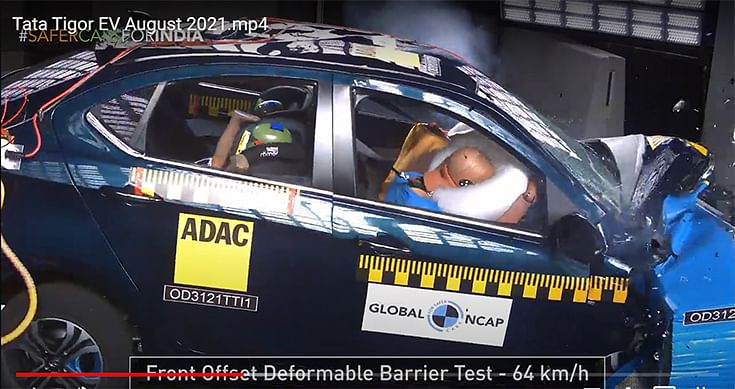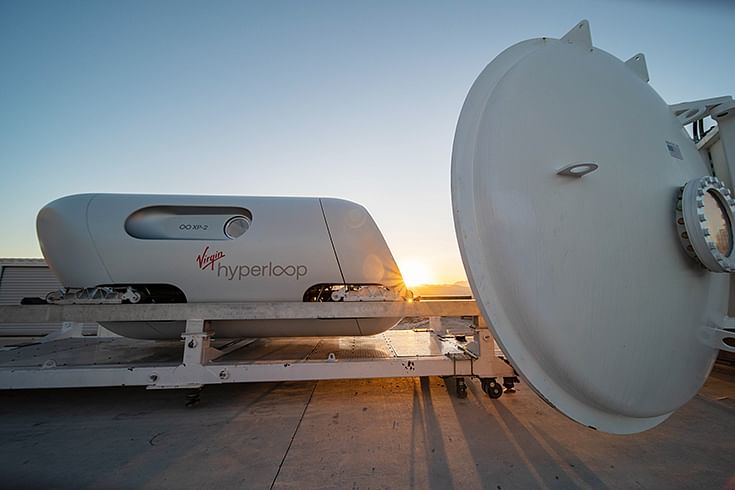First passengers on Virgin Hyperloop have safe – and very speedy – travel experience
The passengers in the first demo were transported over a distance of 500 metres in a mere 15 seconds in the test pod, which was designed to fit only two people.
Transportation history was made on November 8 in the Nevada desert, where US-based transportation technology firm Virgin Hyperloop tested human travel in a hyperloop pod for the first time.
The system can propel passenger or cargo pods at speeds of over 1,000kph. That is 3x faster than high-speed rail and more than 10x faster than traditional rail.
The passengers in the first demo were transported over a distance of 500 metres in a mere 15 seconds in the test pod, which was designed to fit only two people. The final product, however, will have a seating capacity of 28 passengers, according to Virgin Hyperloop.
“For the past few years, the Virgin Hyperloop team has been working on turning its ground breaking technology into reality,” said Sir Richard Branson, founder of the Virgin Group. “With today’s successful test, we have shown that this spirit of innovation will in fact change the way people everywhere live, work, and travel in the years to come.”
Josh Giegel, Co-Founder and Chief Technology Officer, and Sara Luchian, Director of Passenger Experience, were the first people in the world to ride on this new form of transportation. The test took place at Virgin Hyperloop’s 500-metre DevLoop test site in Las Vegas, where the company has previously run over 400 unoccupied tests.
“When we started in a garage over 6 years ago, the goal was simple – to transform the way people move,” said Giegel. "Today, we took one giant leap toward that ultimate dream, not only for me, but for all of us who are looking towards a moonshot right here on Earth.”
Ace of pace
The occupants made their maiden voyage on the newly-unveiled XP-2 vehicle, designed by BIG – Bjarke Ingels Group and Kilo Design, which was custom-built with occupant safety and comfort in mind. While the production vehicle will be larger and seat up to 28 passengers, this 2-seater XP-2 vehicle was built to demonstrate that passengers can in fact safely travel in a hyperloop vehicle.
“Hyperloop is about so much more than the technology. It’s about what it enables,” said Sara Luchian, Director of Passenger Experience for Virgin Hyperloop. “To me, the passenger experience ties it all together. And what better way to design the future than to actually experience it first-hand?”
Sultan Ahmed Bin Sulayem, Chairman of Virgin Hyperloop and Group Chairman and CEO of DP World, watched this historic passenger testing first-hand. “I had the true pleasure of seeing history made before my very eyes – to witness the first new mode of mass transportation in over 100 years come to life,” he said. “I have always had tremendous faith in the team at Virgin Hyperloop to transform this technology into a safe system, and today we have done that. We are one step closer to ushering in a new era of ultra-fast, sustainable movement of people and goods.”
The testing campaign, from the beginning stages all the way through to successful demonstration, was overseen by the industry-recognised Independent Safety Assessor (ISA) Certifer. Having undergone a rigorous and exhaustive safety process, the XP-2 vehicle demonstrates many of the safety-critical systems that will be found on a commercial hyperloop system and is equipped with a state-of-the-art control system that can detect off-nominal states and rapidly trigger appropriate emergency responses.
“I can’t tell you how often I get asked ‘is hyperloop safe?,’” said Jay Walder, CEO of Virgin Hyperloop. “With today’s passenger testing, we have successfully answered this question, demonstrating that not only can Virgin Hyperloop safely put a person in a pod in a vacuum environment, but that the company has a thoughtful approach to safety which has been validated by an independent third party.”

How does Hyperloop work?
With hyperloop, vehicles, called pods, accelerate gradually via electric propulsion through a low-pressure tube. The pod floats along the track using magnetic levitation and glides at airline speeds for long distances due to ultra-low aerodynamic drag.
Virgin Hyperloop estimates that the top speed for a passenger vehicle or light cargo will be 670 miles per hour or 1080 kilometres per hour. That is about 3 times faster than high-speed rail and 10-15 times faster than traditional rail. The average speed vehicles travel will vary based on the route and customer requirements.
The company says, “Hyperloop is designed to be inherently safer than other modes, with multiple redundancies in place. Our system operates autonomously in an enclosed tube and is not susceptible to weather delays, accidents from at-grade crossings, human error, or power outages. Our proprietary high-speed switching architecture eliminates unsafe track configurations and moving trackside parts, a failure point of traditional rail with mechanical switches.”
The Indian connection
In February 2018, the government of Maharashtra signed an agreement with Virgin Hyperloop to construct the Hyperloop One between Mumbai and Pune. Once functional, this system would link central Pune, Navi Mumbai International Airport, and Mumbai and slash travel time from around three hours currently to just around 25 minutes.

The high-capacity passenger and cargo hyperloop route eventually will support 150 million passenger trips annually, saving more than 90 million hours of travel time, and provide citizens with greater opportunities and social and economic mobility. The Hyperloop system will also have the potential for the rapid movement of palletised freight and light cargo between the Mumbai port and Pune, creating a robust backbone for on-demand deliveries, supply chains, and next-generation logistics.
The 100 percent electric, efficient hyperloop system will help ease severe traffic congestion on the Mumbai-Pune Expressway and could reduce greenhouse gas emissions by up to 150,000 tonnes annually.
More recently, on September 27, 2020, Virgin Hyperloop and Bangalore airport inked an MoU to conduct a feasibility study to develop high-speed corridors. At speeds of up to 1,080kph, hyperloop could transport thousands of passengers per hour from Bangalore airport to the city centre in under 10 minutes, something which currently takes close to three hours.

<>
Reducing traffic on the roads
According to Virgin Hyperloop, “ The number of cars is set to double worldwide by 2040, same with air and trucking. We are already dealing with the effects of pollution, lack of access, and congestion. If we only invest in the same technologies we’ve had for more than a century, tomorrow will look like today, only much worse. It’s been over a century since the Wright Brothers first showed us human flight was possible. It’s time for a new era in transportation capable of carrying us forward for the next 100 years.
We aren't just building a hyperloop; we're building a network of public and private partners to scale an integrated supply chain ecosystem. Our business model is based on partnerships that create local jobs and opportunities for those who choose to invest in this technology. We are working at the highest level of governments around the globe to put in place commercial agreements to make hyperloop a reality.
Without a massive leap forward, pollution from the transportation industry is expected to almost double by 2050 – well above the carbon budget. By combining an ultra-efficient electric motor, magnetic levitation, and a low-drag environment, the VHO system can reach airline speeds for 5-10x less energy (depends on route length) and can go faster than high-speed rail using less energy. In regions like the Middle East, we could power the system completely by solar panels which cover the tube. As fighting against climate change becomes an existential issue for cities across the globe, hyperloop will create a new, shared, electric mobility model for helping to permanently reform an industry with some of the world’s highest carbon emissions.”
It is felt that the safety demonstration achieved with this test will pave the way for the certification of hyperloop systems around the world – a key step towards commercial projects.
(With inputs from Akbar Merchant, Autocar India)
RELATED ARTICLES
Autoliv Plans JV for Advanced Safety Electronics With China’s HSAE
The new joint venture, which is to be located strategically near Shanghai and close to several existing Autoliv sites in...
JLR to Restart Production Over a Month After September Hacking
Manufacturing operations at the Tata Group-owned British luxury car and SUV manufacturer were shut down following a cybe...
BYD UK Sales Jump 880% in September to 11,271 units
Sales record sets the UK apart as the largest international market for BYD outside of China for the first time. The Seal...






 By Autocar Professional Bureau
By Autocar Professional Bureau
 15 Nov 2020
15 Nov 2020
 10751 Views
10751 Views


























 Ajit Dalvi
Ajit Dalvi




